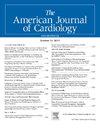经导管主动脉瓣植入术后五年假体与患者不匹配的测量和预测结果。
IF 2.3
3区 医学
Q2 CARDIAC & CARDIOVASCULAR SYSTEMS
引用次数: 0
摘要
背景:有关经导管主动脉瓣植入术(TAVI)后假体与患者不匹配(PPM)的长期结果的数据仍存在争议:本研究旨在调查经导管主动脉瓣植入术(TAVI)患者的测量PPM(PPMM)和预测PPM(PPMP)的发生率和临床结果:这是一项回顾性分析,对象是2012年至2021年间在一家大型医疗系统接受TAVI手术的3016名患者。出院时使用连续性方程测量了与体表面积相关的有效孔面积(EOAi)。EOAi根据已公布的预测表对每种型号和瓣膜大小进行预测。主要终点是 5 年存活率:平均年龄为80岁,55.6%为男性。平均STS风险评分为4.66%。74.9%的患者接受了BEV,25.1%接受了SEV。根据预测 EOAi 与测量 EOAi(0.8% 与 6.3%,P < 0.001)以及 SEV 与 BEV(5.3% 与 6.6%,P= 0.02)进行评估,严重 PPM 的发生率明显降低。无论是否存在高残压阶差,重度PPMp或重度PPMM均与5年死亡率无关(分别为HR=1.26,95% CI=0.96-1.66,P=0.095;HR=1.03,95% CI=0.42-2.49,P=0.954)。无论 PPM 的定义或严重程度如何,BEV 或 SEV 均与 5 年死亡率的增加无关:在这项大型医疗系统分析中,严重PPMP和严重PPMM都与5年全因死亡率无关。无论PPM的定义或严重程度如何,BEV和SEV在死亡率方面均无差异。本文章由计算机程序翻译,如有差异,请以英文原文为准。
Five-Year Outcomes of Measured and Predicted Prosthesis-Patient Mismatch following Transcatheter Aortic Valve Implantation
Data on the long-term outcomes of prosthesis patient mismatch (PPM) after transcatheter aortic valve implantation (TAVI) remain controversial. This study aimed to investigate the incidence and clinical outcomes of measured PPM (PPMM) and predicted PPM (PPMP) in patients who underwent TAVI. This is a retrospective analysis of 3,016 patients who underwent TAVI at a large health care system between 2012 and 2021. Effective orifice area indexed to body surface area (EOAi) was measured at discharge using the continuity equation. EOAi was predicted according to the published predictive tables for each model and size of the valve. Primary end point was 5-year survival rate. Mean age was 80 years, and 55.6% were male. The mean Society of Thoracic Surgeons risk score was 4.66%. 74.9% of patients received a balloon-expandable valve (BEV), and 25.1% received a self-expanding valve (SEV). The incidence of severe PPM was markedly lower when defined by predicted versus measured EOAi (0.8% vs 6.3%, p <0.001) and when assessed in SEV versus BEV (5.3% vs 6.6%, p = 0.02). Neither severe PPMp nor severe PPMM was associated with 5-year mortality (hazard ratio 1.26, 95% confidence interval 0.96 to 1.66, p = 0.095; hazard ratio 1.03, 95% confidence interval 0.42 to 2.49, p = 0.954, respectively), irrespective of the presence of high residual pressure gradient. Neither BEV nor SEV was associated with an increased 5-year mortality, irrespective of PPM definition or severity. In this large health care system analysis, neither severe PPMP nor severe PPMM was associated with 5-year all-cause mortality. There was no difference between BEV and SEV in terms of mortality, irrespective of the definition or severity of PPM.
求助全文
通过发布文献求助,成功后即可免费获取论文全文。
去求助
来源期刊

American Journal of Cardiology
医学-心血管系统
CiteScore
4.00
自引率
3.60%
发文量
698
审稿时长
33 days
期刊介绍:
Published 24 times a year, The American Journal of Cardiology® is an independent journal designed for cardiovascular disease specialists and internists with a subspecialty in cardiology throughout the world. AJC is an independent, scientific, peer-reviewed journal of original articles that focus on the practical, clinical approach to the diagnosis and treatment of cardiovascular disease. AJC has one of the fastest acceptance to publication times in Cardiology. Features report on systemic hypertension, methodology, drugs, pacing, arrhythmia, preventive cardiology, congestive heart failure, valvular heart disease, congenital heart disease, and cardiomyopathy. Also included are editorials, readers'' comments, and symposia.
 求助内容:
求助内容: 应助结果提醒方式:
应助结果提醒方式:


